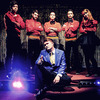The pen may be mightier than the sword when circumstances suit, but in gaming – from the Zelda series’ Link to Metal Gear Rising: Revengeance’s Raiden via Final Fantasy VII’s Cloud Strife – it’s clear that having a bloody great blade in your hand can work wonders in sticky situations.
The story side of modern games development is a bigger deal now than it ever has been, though, with a raft of well-known movie scriptwriters and best-selling authors lending their talents to the industry.
Alex Garland, the writer behind The Beach, Sunshine and 28 Days Later, worked on both Enslaved: Odyssey To The West and 2013’s DmC: Devil May Cry (reviewed back in March), for developer Ninja Theory. The game that was the biggest entertainment launch of all time until Grand Theft Auto V, Call Of Duty: Black Ops II (reviewed), featured a campaign storyline written by David Goyer, probably best known for his work on the Christopher Nolan-directed Batman films.
But no studio out there really emphasises the storyline in their games – sorry, interactive dramas – more than the David Cage-fronted Paris developer Quantic Dream. Indeed, it appears to be their entire M.O. Cage’s latest self-written-and-directed release is the PlayStation 3 exclusive Beyond: Two Souls which, much like its 2010 predecessor Heavy Rain, relies on simple screen prompts to progress through its twisty, out-of-chronological-order narrative. Thrust the right stick this way to pick up a beer; depress the X button to look at the band play; hold four buttons at once to reach the game’s climax (sort of).
If you’ve played a Quantic Dream game before, yup, it’s more of that gestural business – not that the commands you input are always the most natural of fits for what’s playing out on screen. Keeps you on your toes. And I’m fine with that. Beyond: Two Souls is precisely what it sets itself out to be: interactive drama. The route from A to Z can be different each time you play it, but you’ll always get to the end – sit down, tap here and lunge there, and 10 hours later you’ll see one of several pre-credits sequences. Like another Quantic Dream game, 2005’s Fahrenheit (aka Indigo Prophecy), Beyond: Two Souls begins with a blinding bang, works its way through some serious emoting, and then goes entirely batshit come its ‘final reel’.
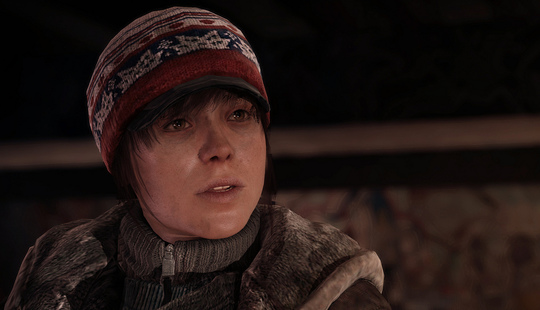 This is Ellen Page. You'll see a lot of her...
This is Ellen Page. You'll see a lot of her...
The ‘interactive drama’ does feature its share of point-gun, shoot-gun moments, but everything is so heavily scripted that the player will never experience a game-over screen. Some sections, if failed, do need to be repeated, although these come early on and are really just there to teach you the basics before The Real Deal later on. Play switches, via the triangle button, between the human Jodie (from her childhood to early 20s) and the spirit – the “entity” – that she’s forever been joined to, Aidan (all is explained towards the end). As the latter, you can float relatively freely around, possessing enemies, finding hidden switches, tearing apart evil apparitions, and generally causing mayhem to hinder whoever or whatever is threatening Jodie.
Cage presents a flawed but promising product with Beyond: Two Souls. The technology on show leads to some breath-taking visuals that render the player lost in its most engaging moments: a touching scene between Jodie and her mother; another where she helps a homeless man, Stan, reconnect with his past. (I did experience one frozen screen, directly after a revelation-style scene – this necessitated a system restart, which rather broke the spell.) The presentation is top notch, in short, and the controls… Look, you know what you’re getting, so why pretend it’s going to be like The Last Of Us?
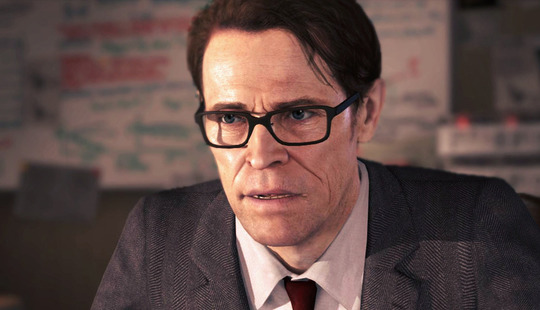 This is not Ellen Page. You won't see quite as much of him...
This is not Ellen Page. You won't see quite as much of him...
As a fan of what Quantic Dream is doing, I wish Cage could let go of the writer reigns on a project, just once, and focus instead on the amazing technology and A-list draw that his company has – Ellen Page and Willem Dafoe fill the leading roles here, and the supporting cast is full of great performances. He could get someone in from the world of cinema, someone who best understands how to see a story out to its very end without everything turning doomsday on humanity. Right now, Cage is trying to force video games into a cinematic context, when what’d arguably work better is to bring the worlds together by harmonious association rather than through one person’s vision of how they should meet. Beyond: Two Souls is a great experience, but look hard enough at its story shortcomings and the whole does begin to unravel.
The PEGI-16 themes of Beyond: Two Souls ensure that it’s an adults-only affair – even with the last-minute edits for its European release, which brought it down from an 18, the game features nudity (what would a Quantic Dream game be without a shower scene, or even two?), extreme violence and moments of skin-tingling terror that’d likely leave younger gamers up all night. But another recently released PlayStation 3 exclusive bearing a compellingly original story is a slightly more kids-friendly affair.
Puppeteer slipped into stores just prior to the all-conquering juggernaut of GTA V, so you’re forgiven for not noticing it. But when there’s a space in your schedule for another charmingly colourful platformer – Rayman Legends being the first you should turn to, of course – please do check it out.
Developed by SCE Japan Studio, whose credits include the singularly original Tokyo Jungle and the forthcoming PS4 launch title Knack, Puppeteer is a deliciously dark fairy tale told through clanking marionettes making their way across ever-changing sets on a stage presented with curtains either side, a cheering and booing audience, a wonderfully spot-lit protagonist, and a narrator with the most plummy of English accents. (The trailer above shows this off better than I can explain it.)
You play as Kutaro, one of many boys on Earth whose soul has been spirited away to the Moon, courtesy of the Big Bad of this adventure, the Moon Bear King. He’s a rotter and no mistake, and our first introduction to the cantankerous antagonist sees him bite poor Kutaro’s head clean off. It should be added at this point that the souls brought to the Moon are used to power puppet guards for the Moon Bear King… no Actual Human Boy gets his bonce munched here. Still, it’s a pretty grizzly (oh, ha ha) beginning, and we initially control Kutaro sans-head.
And this is where the fun starts. You find different heads, and they grant you different powers… Sometimes, at least. You see, the various heads available in each stage (seven in total, each split into three acts) are collectibles first, and active game-changers second. With the right head, in the right place, Kutaro can open secret bonus rooms – yet the situation is rare when you’ve got the correct head to access such areas. You can replay acts once they’re completed, though, so expect to discover most of Puppeteer’s secrets through repeat visits, rather than a first play through.
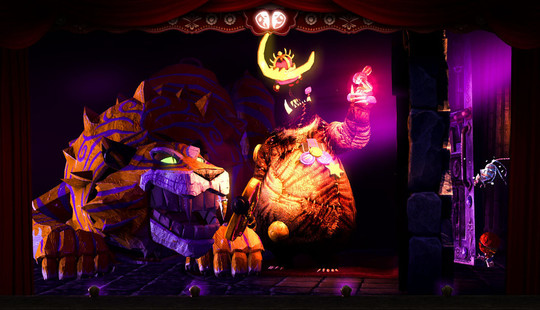 So a tiger and a bear walk into a bar, and the barkeep, he says...
So a tiger and a bear walk into a bar, and the barkeep, he says...
The story is a lot of fun, though – enough to keep you trotting along until all of the Moon Bear King’s fiendish generals (a tiger, a snake, a rat, a dragon, a pig… was someone looking at the Chinese zodiac while writing this?) are done away with. There are overtones of Tim Burton at play, an atmosphere somewhat comparable with the twisted fantasy of Edward Scissorhands (and the reason for that is just coming up…). There aren’t any real scares, but if you’re playing this with young kids in the room, do be wary that the Moon Bear King is a loud and short-tempered sort whose tolerance for failure is minimal indeed.
With plentiful lives, Puppeteer is not a difficult game. But it is a sometimes fiddly one, as jumps that seem easy enough take a turn for the precise and a handful of boss fights fall victim to tiresome quick-time events that, while great to watch, strip the fun from actually taking these huge enemies apart.
And take them apart you certainly do – very early on, Kutaro finds some magical scissors, which he can use both offensively and to traverse some parts of the environments, snipping his way through material to travel upwards, or cutting through paper clouds to cross an un-jumpable drop. As you progress, further special abilities are unlocked. You can block projectiles, sending them back from where they came to blast enemies; you can toss bombs here and there to activate springboards and clear your path. The expanding of Kutaro’s skill set is well paced, and no obstacle is ever so testing that it can’t be beaten by using a combination of these special abilities.
Cute it’s not – I mean, this is a game that encourages running with scissors – but Puppeteer’s originality is an incredible strength, and its audio-and-visual presentation is special indeed, the wooden look to each character strikingly well realised.
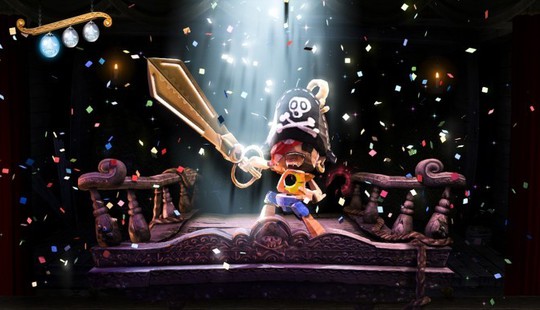 Something about bringing some bloody great scissors to a cutlass fight...
Something about bringing some bloody great scissors to a cutlass fight...
Fantastic tales written with compelling quirkiness are great and all, but thinking back to some of my favourite gaming experiences as a kid, they weren’t titles with linear plotlines. Indeed, some of the games I can remember sinking deeply into didn’t have plots at all – they were sports games, like Wimbledon on the Master System, Sensible Soccer on the Amiga, and EA Hockey on the Mega Drive.
A recently published feature on Edge’s website focused on Football Manager – and its telling of the events, and knock-on effects, of a single match made for some terrific reading. (Find the article here.) The piece got me thinking back to the stories I’d seen play out on, okay, rather simpler games, but nevertheless games that didn’t come with a predetermined plot. And it made me wonder if I could still feel that – if I could still find myself as hooked by a sports title in 2013 as I have been by BioShock Infinite, by The Last Of Us, and by Beyond: Two Souls (whatever its narrative shortcomings, I was still glued to it).
My test subject: Pro Evolution Soccer 2014. Konami’s long-running PES series has had its crown as the best console football experience robbed by FIFA in recent years, and from reading reviews it seems that the 2014 iterations of each game maintain that status quo. But PES 2014 is a fine simulation of the beautiful game, whatever you compare it to, with a deeply layered set of controls that slowly become second nature to the player. And, in my case, that means really slowly – the last football game I played at any length was FIFA 10, and I’d not played a PES title since the one with England’s Brave John Terry on the front… 2006? 2007? Something like that.
Dive right into PES 2014 and the first impressions are not amazing. Its menus are awful. Its music is grating. (Okay, it’s initially a thrill to hear the UEFA Champion’s League Anthem blare out of the telly when setting up for a Manchester United versus Fiorentina match, but that gets old after a couple of instances.) The commentary, from Jon Champion and Jim Beglin, is woeful – full of mistakes, and repeating lines that I used to hear all of the time when playing the England’s Brave John Terry version way back when. “Some sections of the crowd were expecting red,” and so forth. It’s a tremendously inconsistent commentary, too, with Beglin remarking that a shot was pretty decent seconds after Champion’s announced how awful it was.
Persist, though – through a handful of low-scoring matches at amateur level, until those games become too easy and it’s time to get ‘regular’, which is the third-highest of four difficulty settings – and PES 2014 transforms. Selecting an over-powered England side proves to be a joy, the quality of the player models and their animation high indeed and the pace at which they tear Wales apart quite terrifying to behold – the match in question ends 4-0 to the English, but I register 27 shots in 10 minutes. Another international fixture ends 4-0, as I play as Peru and crush my neighbours Ecuador. Then, as Morocco, I edge past Greece 1-0 – it’s a tight match remarkable only for the announcement by Champion that the Greeks are kicking off when it’s actually the Moroccans.
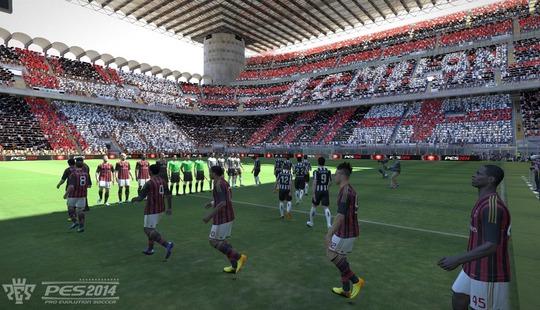 This is not Hampshire Reds in action...
This is not Hampshire Reds in action...
And now I’m thinking: let’s do it, let’s take charge of The Team, My Team, Southampton… or Hampshire Reds as they’re known in PES Land. So I do, and after a little tinkering I’ve added the previously absent Dani Osvaldo and Victor Wanyama to the ranks, jettisoning Dean Hammond (thanks for everything!) and Jonathan Forte (thanks for nothing!). I’m ready. Ready to tackle the UEFA Europa League.
I’m in deep before I’ve even begun. I’m cursing the slow-as-slurry menu cursor as I click my team’s tactics into shape. I set three distinct options: the first a straightforward 4-3-3 using Rickie Lambert as a frontman flanked by Osvaldo and Gastón Ramírez – although, interestingly, Jason Puncheon is ranked just as highly as the Uruguayan international, so he’s on the bench as a readymade replacement should Gastón’s legs fail him. My midfield’s strong: Lallana linking with my front three while Wanyama and a choice between Steven Davis and Morgan Schneiderlin keep things tidy between attack and defence. At the back I’ve Fonte and Lovren, with forward-bombing fullbacks Clyne and Shaw completing the outfield. Artur’s my stopper. Why wouldn’t he be?
My other two tactical options – switchable with one touch of the D-pad during gameplay – see the team shift to a mainly attacking set-up with Lallana and Davis pressing onwards, or dropping deep to allow for counter-attacking potential. My selected style of play, at kick-off, is to keep my possession percentage high and work through the opposition lines slowly, looking for the killer through ball without over-committing numbers. And, to start with, it works.
A decent 0-0 at home to Valencia begins my group. The Spaniards have a goal chalked off for offside; I barely threaten their 18-yard box, any shots coming in from distance. But everything changes in the next match as my Southampton rolls over Danish team Nordsjaelland on their own turf. The result’s only 1-0 but the statistics tell a story of outright dominance (seems I need to work on my finishing – at the time of writing my shots-to-goals conversion rate is just 12.33%). Next up is Celtic, and I register a 3-0 away win (Lambert with a second-half hat-trick) and scrape past the Scots 1-0 at ‘St Mary’s’ courtesy of a Jay Rodriguez volley.
Qualification practically in the bag, it’s Valencia away next and I shuffle my pack. Changes are wholesale. In comes the second string. And, amazingly, I take the lead early – there’s a charge down the left side from James Ward-Prowse, and after a few penalty box deflections the ball somehow rolls into the Valencia net off the shins of one of their own players. And here’s where a newly introduced feature of PES seems to come into its own: ‘The Heart’.
When a team is down, their supporters can cheer them on to perform beyond themselves. We see it in football all the time – and in PES 2014, this is ‘The Heart’, a system that, although activating without any on-screen indication, buoys a team to up its game. After seeing their crossbar rattled twice in the second half, by Lambert and Osvaldo, Valencia finally rise to the occasion. Roberto Soldado, who didn’t complete his Spurs move in time for it to be represented here, equalises in the 85th minute after a spell of persistent pressure where I just can’t keep the ball out of my half. It’s the first goal I’ve conceded since opening this game, and I feel entirely broken.
Something must still be up when I play at home against Nordsjaelland, as a tedious 0-0 is played out. The woodwork’s struck a couple of times, and the Danes’ keeper is awarded man of the match. It’s enough though: 12 points puts Southampton top of the group, the reward a last-32 tie against Legia Warsaw. No problem, right?
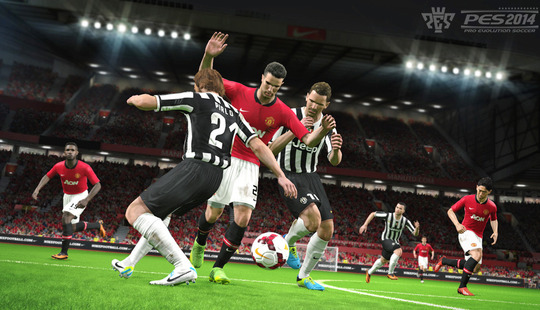 This, too, is not Hampshire Reds in action...
This, too, is not Hampshire Reds in action...
Southampton return from Poland 2-0 down on aggregate. It’s my first defeat. I feel even more broken than I was before. My team dominates the first half, registering 11 shots on goal. But a messy second half leaves it all to do in the second leg. Where, it must be said, things begin brightly: Lambert scores after five (game) minutes, and then a scissor-kick finish from Osvaldo, on the end of a deep Ramírez cross, levels things up midway through the first half. It’s going to happen, I can feel it… A third is there to be had. And it’s nearly taken so many times. Lambert is denied when one-on-one with the Warsaw keeper. Throughout the second half the Poles are pegged back – they spring the occasional counter attack, but they come to nothing. I’m on top of this. It’s going to happen.
And then, at the very beginning of the second period of extra time, disaster. PES 2014 does suffer from occasionally sticky controls – inputs don’t always seem to be recognised instantly, and the direction you’re intending to strike a pass might not always be where the ball ends up. But I can’t blame these things for a defensive mix-up that leaves Lovren and Fonte in no-man’s land as a Warsaw forward intercepts an appallingly wayward back-pass… and slots the ball beneath the angle-narrowing Boruc. FFS.
And so, my story’s over. This one at least – there will be more, as once PES 2014 gets its various kinks out of the way (and it’s got its share), what’s left is a pretty damn impressive game of kicking, one that does warrant return visits. Do I see myself drawing my own knockout trees out on notepads, and then playing my own tournaments via a series of ‘friendlies’, as I did with Wimbledon? Will I get as competitive with this as I did with EA Hockey, on which I shared a healthy rivalry with a lives-over-the-road best mate back in the early 1990s? It’s unlikely – Assassin’s Creed IV: Black Flag and Watch Dogs are about to come out, and will eat away at what hours I get to enjoy my games.
But PES 2014 proves, to me at least, that some of the best stories experienced via video games don’t need to be longwinded, big-budget affairs starring the Hollywood elite. They can be told by missed chances and overturned odds, through an assortment of avatars that, in the case of Hampshire Reds at least, bear no resemblance whatsoever to their real-life counterparts (anyone who sees this Rickie Lambert and thinks he’s a ringer for that Rickie Lambert needs immediate medical assistance). An inch left of the post is as significant as a lighthouse, a last-minute chance blazed over as tough to stomach as choosing between Doug and Carley. And the only pens you care about are those won by duping a defender into putting in a rash challenge.

Best. Game. Ever: Daedelus
I asked Alfred Darlington, aka Los Angeles electronic artist Daedelus, what his favourite game was. And he told me. Words below. The new Daedelus album, Drown Out, is out now on Anticon.
“Before we took games into the home, or even worse in hand with a screen six inches from our eyes, the glory was to be had in an arcade, awaiting the next challenger.
“Street Fighter II is the baseline player vs. player game that all others are judged against. Good for pubescent hands, it served as a martial arts escape route in roundhouse kicks and uppercuts. You could get lucky and be victorious with button mashing, but never against an opponent who took the time to learn their character. Those who ever stood upright in an actual arcade can tell you with pride that with practice one could transform into a combo-ing, juggling and eventually parrying player that garnered Perfects and glory.
“I ridiculously had tournament ambition with later Street Fighter II editions, but that first iteration, with all of its pirate remixes, was thrilling and actually felt dangerous in LA’s darker reaches – all my quarters belong to it. In strip malls there was always a machine to be challenged on, and once I even had a gun pulled on me, silly as that sounds. To boys of that age of testing and trying, you didn’t need actual roughhousing to know your masculinity was tied up in this virtual fighter.
“So while I thoroughly destroyed this young wannabe (he wore enough blue to tell me I should worry, but Street Fighter II seemed removed from colours bickering), he simply pulled a gun from the front of his belt and spit out, ‘Walk away.’ I don’t remember any conflict in the decision. I shuffled away well enough, without putting up another quarter, but it seemed unfair at a very basic level, and an important lesson in victories earned and those best left to others.
“My characters were Dhalsim, Blanka and E. Honda, and I was mercilessly teased for it. But who really wanted to be gingerbread Ken or crew-cut Guile anyways?!?”
Beyond: Two Souls and Puppeteer tested on PlayStation 3 (both are exclusive to Sony’s console). PES 2014 tested on Xbox 360 and also available now for PS3 and PC, with PSP, PS2 and 3DS versions announced.
I almost forgot to mention: I played a game of Surgeon Simulator 2013 at the Eurogamer Expo, held at Earl's Court the other week. Big deal, eh? Well, get this - I played it on an Oculus Rift. And I've not laughed so hard at my own failings as a gamer in all my life - I managed to murder my patient inside three minutes. An electric drill to the ribcage seemed like the right idea at the time. I sucked, but I did so while having super fun. For those at the back, the Oculus Rift is a virtual reality headset that used Kickstarter to properly fund its development, eventually raising well over two million dollars for its makers, Oculus VR. A consumer version is still some way off, but take my word for it, please: if you get the chance to strap one of these on, do so. And try not to do a tiny wee in excitement.
Oh, I played some PlayStation 4 and Xbox One games while I was there, too. They looked real pretty.
NEXT TIME: I suppose we'd better start thinking about the games of the year, and perhaps some of the worst that 2013 has had to offer, too. In terms of crushing disappointments, I can turn immediately to Colonial Marines: what a waste of an amazing opportunity. And from the entirely unexpected corner, perhaps Year Walk - if you're yet to look up this amazing iOS game from mobile developer Simogo, do so immediately. More along these lines, next time.





